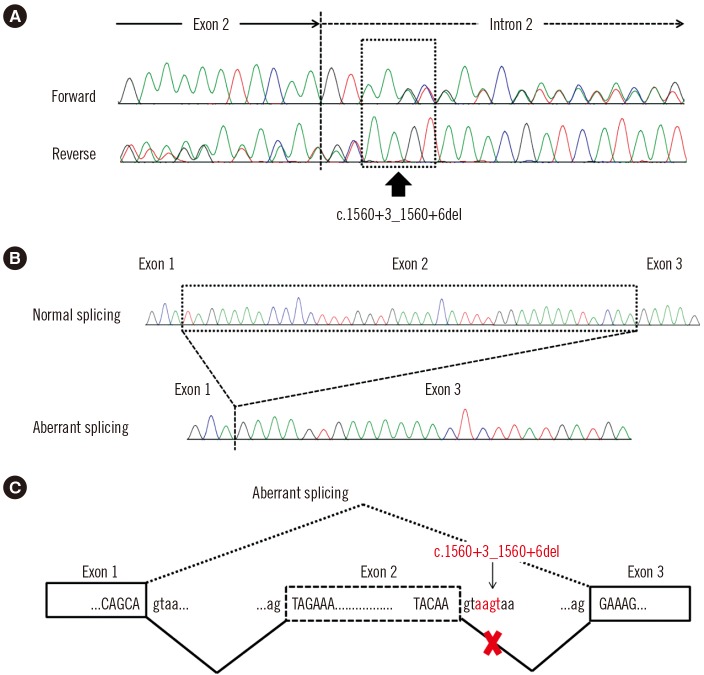Ann Lab Med.
2017 Nov;37(6):540-543. 10.3343/alm.2017.37.6.540.
Novel 4-bp Intronic Deletion (c.1560+3_1560+6del) in LEMD3 in a Korean Patient With Osteopoikilosis
- Affiliations
-
- 1Department of Laboratory Medicine and Genetics, Samsung Medical Center, Sungkyunkwan University School of Medicine, Seoul, Korea. changski@skku.edu ykmin@skku.edu
- 2Division of Endocrinology and Metabolism, Department of Medicine, Samsung Medical Center, Sungkyunkwan University School of Medicine, Seoul, Korea. changski@skku.edu ykmin@skku.edu
- KMID: 2425998
- DOI: http://doi.org/10.3343/alm.2017.37.6.540
Abstract
- Osteopoikilosis is an autosomal dominant bone disorder characterized by symmetric multiple osteosclerotic lesions throughout the axial and appendicular skeleton. Pathogenic variants in the LEMD3 have been identified as the cause of osteopoikilosis. LEMD3 encodes an inner nuclear membrane protein that interacts with bone morphogenetic protein (BMP) and transforming growth factor (TGF)-β pathways. We report the case of a 19-year-old man presenting with lower back pain and sciatica. His radiograph revealed bilateral and symmetrical multiple osteosclerotic bone lesions in both scapular areas. Sanger sequencing of LEMD3 revealed a four-base-pair deletion in intron 2 (c.1560+3_1560+6del), which was inherited from his father. We found that this four-base-pair deletion in intron 2 causes aberrant splicing and consequent deletion of exon 2. To the best of our knowledge, this is the first report of genetically confirmed osteopoikilosis in Korea.
Keyword
MeSH Terms
Figure
Reference
-
1. Korkmaz MF, Elli M, Özkan MB, Bilgici MC, Dağdemir A, Korkmaz M, et al. Osteopoikilosis: report of a familial case and review of the literature. Rheumatol Int. 2015; 35:921–924. PMID: 25352085.2. Paraskevas G, Raikos A, Stavrakas M, Spanidou S, Papaziogas B. Osteopoikilosis: a case report of a symptomatic patient. J Radiol Case Rep. 2009; 3:38–43. PMID: 22470634.3. Benli IT, Akalin S, Boysan E, Mumcu EF, Kiş M, Türkoğlu D. Epidemiological, clinical and radiological aspects of osteopoikilosis. J Bone Joint Surg Br. 1992; 74:504–506. PMID: 1624505.4. Debeer P, Pykels E, Lammens J, Devriendt K, Fryns JP. Melorheostosis in a family with autosomal dominant osteopoikilosis: report of a third family. Am J Med Genet A. 2003; 119A:188–193. PMID: 12749062.5. Hellemans J, Preobrazhenska O, Willaert A, Debeer P, Verdonk PC, Costa T, et al. Loss-of-function mutations in LEMD3 result in osteopoikilosis, Buschke-Ollendorff syndrome and melorheostosis. Nat Genet. 2004; 36:1213–1218. PMID: 15489854.6. Kim Y, Kim YI, Moon MK. Osteopoikilosis - Report of 6 cases. J Korean Orthop Assoc. 1978; 13:433–438.7. Yune SH, Lee JK, Ahn SR, Rha SY, Park CH. A case report of familial osteopoikilosis. J Korean Orthop Assoc. 1986; 21:1133–1136.8. Jun S, Kim YK, Kim IJ, Nam HY, Kim BS. Innumerable small bony nodular sclerotic lesions with negative findings on both bone scintigraphy and F-18 FDG PET: Osteopoikilosis in a patient of breast cancer. Nucl Med Mol Imaging. 2008; 42:256–258.9. Yoo JH, Park YW, Park JS, Rowe KC, Chung KJ, Kim HK, et al. Non-familial osteopoikilosis around the both hip joints: a case report. J Korean Hip Soc. 2010; 22:86–89.10. Richards S, Aziz N, Bale S, Bick D, Das S, Gastier-Foster J, et al. Standards and guidelines for the interpretation of sequence variants: a joint consensus recommendation of the American College of Medical Genetics and Genomics and the Association for Molecular Pathology. Genet Med. 2015; 17:405–424. PMID: 25741868.11. Reid EM, Baker BL, Stees MA, Stone SP. Buschke-Ollendorff syndrome: a 32-month-old boy with elastomas and craniosynostosis. Pediatr Dermatol. 2008; 25:349–351. PMID: 18577041.12. Zhang Y, Castori M, Ferranti G, Paradisi M, Wordsworth BP. Novel and recurrent germline LEMD3 mutations causing Buschke-Ollendorff syndrome and osteopoikilosis but not isolated melorheostosis. Clin Genet. 2009; 75:556–561. PMID: 19438932.13. Zhang Q, Mo ZH, Dong CS, Yang F, Xie YH, Jin P. Identification of a novel LEMD3 Y871X mutation in a three-generation family with osteopoikilosis and review of the literature. J Endocrinol Invest. 2016; 39:679–685. PMID: 26694706.14. Lin F, Morrison JM, Wu W, Worman HJ. MAN1, an integral protein of the inner nuclear membrane, binds Smad2 and Smad3 and antagonizes transforming growth factor-beta signaling. Hum Mol Genet. 2005; 14:437–445. PMID: 15601644.15. Hershkovitz D, Amitai B, Sprecher E. Familial cutaneous collagenomas resulting from a novel mutation in LEMD3. Br J Dermatol. 2007; 156:375–377. PMID: 17223882.
- Full Text Links
- Actions
-
Cited
- CITED
-
- Close
- Share
- Similar articles
-
- Erratum: Novel 4-bp Intronic Deletion (c.1560+3_1560+6del) in LEMD3 in a Korean Patient With Osteopoikilosis
- A Case Report of Familial Osteopoikilosis
- Innumerable Small Bony Nodular Sclerotic Lesions with Negative Findings on Both Bone Scintigraphy and F-18 FDG PET : Osteopoikilosis in a Patient of Breast Cancer
- Osteopoikilosis: A Case Report
- Hyperpigmented Connective Tissue Nevus in Buschke-Ollendorff Syndrome: A Case Report



